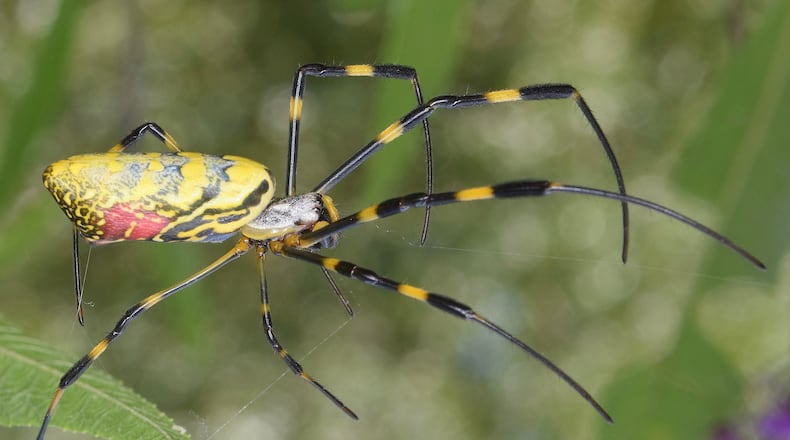This is the time of year when the huge, wheel-shaped webs of big orb-weaving spiders seem to be all over the place — stretched between trees and shrubs along trails and garden paths or across porches, windows and decks.
In recent years, however, extra-large webs have appeared and are increasing in number. They’re made by an exotic orb-weaver called the Joro spider, which first appeared near Athens in 2013. A native of East Asia, the spider is now spreading fast across Georgia and elsewhere in the Southeast.
It seems very abundant this fall, with many Georgia homeowners reporting that Joro spiderwebs have nearly taken over their yards.
University of Georgia researchers call the Joro’s web “super-sized” that can reach nearly 10 feet wide. The bright yellow, blue-black and red spider itself is large with females growing as long as 4 inches. Despite its size, however, the spider is said to be relatively harmless to people and pets.
A major concern, though, is whether the Joro, which arrived here via shipping material, will displace Georgia’s native, common orb-weaving spiders and upset local ecosystems.
Some of the state’s common native orb-weavers include yellow garden, basilica, arrowhead and barn spiders, all of which play valuable ecological roles. “Spiders consume a lot of different prey types, from flies to pest insects,” UGA entomologist Jason Schmidt said. They also are important food sources for a variety of birds, lizards, wasps and mammals.
A UGA research team studying the Joro spider said that no major ecological disruptions have been found so far because of the arachnid, but the jury is still out on that. The researchers already conclude, however, that the Joro is here to stay and will continue to spread, and that homeowners may have to learn to live with it.
Meanwhile, the UGA team is asking for the public’s help — by participating in a weeklong “Joro Spider Spotting Contest” beginning on Sunday. For more information, visit jorowatch.org.
IN THE SKY: From David Dundee, Tellus Science Museum astronomer: The moon will be full on Sunday. Mars rises in the east just after dark and will appear near the moon on Friday night. Jupiter is high in the south at sunset and will appear near the moon Saturday night. Saturn is in the southwest just after dark.
Charles Seabrook can be reached at charles.seabrook@yahoo.com.
About the Author
Keep Reading
The Latest
Featured


